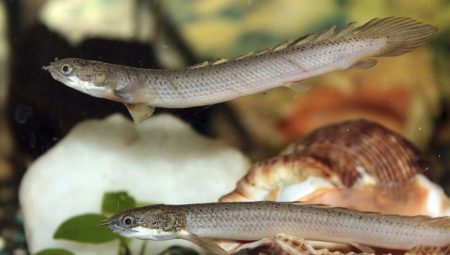Currently, for most consumers, it is important to have an aquarium at home, and its inhabitants go by the wayside. People are used to seeing a set of guppies, neon or goldfish in a typical 50-100 liter home reservoir. And only a small number of aquarists choose to keep very unusual and rare fish with an interesting history. This ancient inhabitant, such as the Senegalese polytherus, will be discussed in this article.
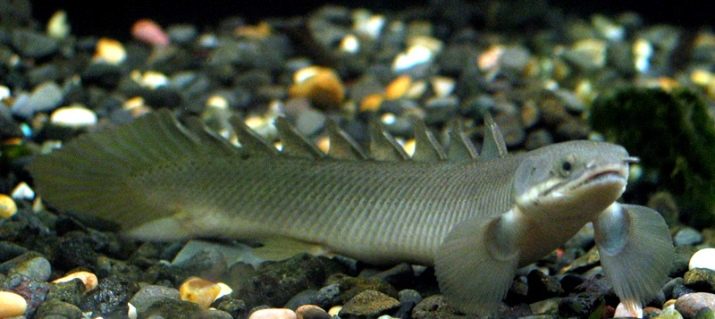
Features
Polytherus of Senegalese is also called the Senegalese dragon or multi-feather. At first glance, you might think that this is an eel, but the polytherus has nothing to do with it. This is a predator from the multi-feather family, from the multi-feather order, the class of ray-feathers. Scientists managed to find out that this fish was born at the end of the Mesozoic era. This species was first described by scientists in 1829.
They could not be attributed to any family known at that time due to too strong differences from other fish species. Then a separate multi-tree family was created.
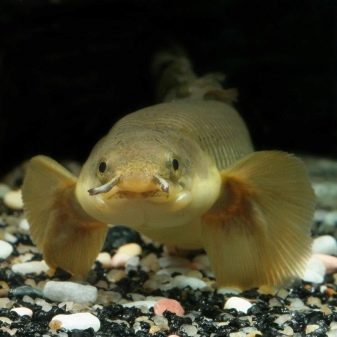
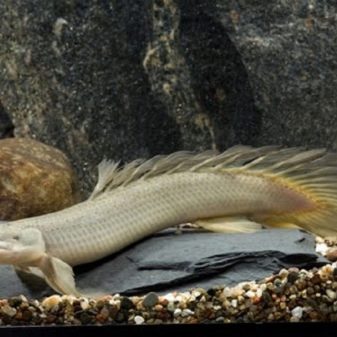
In appearance, the polytherus is more like an ancient pangolin than a familiar fish. It has the following characteristic:
- elongated body, covered with strong diamond-shaped scales, rough to the touch;
- the body is silver-gray with a greenish or bluish tint;
- near the dorsal fin, the color changes to olive, and the abdomen is white.
Young individuals along the body have pale stripes that disappear with age. The skeleton of a polypterus resembles a shark skeleton consisting of cartilage. The head looks like a snake, with elongated nostrils. They are the main assistants in the hunt, since the described fish has poor eyesight and is oriented by smell. A large mouth with a huge number of sharp teeth helps to catch large prey.
The dorsal fin consists of separate ridges, similar to spikes, which can number from 6 to 19 pieces. Because of this kind of fin, it is called the "dragon". This feature also affected the fact thatolipteruses are called multi-feathers.
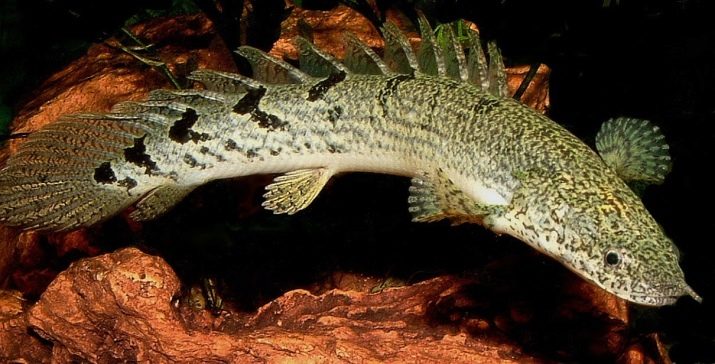
This is a large fish, growing in nature up to 70–90 cm. In an aquarium, individuals do not exceed 40 cm. The size of the pets depends on the size of the aquarium. They have powerful, rounded pectoral fins located behind the head, allowing the polypterus to deftly move not only in water but also on land.
One of the interesting features of this fish is considered double breathing. The swimming bladder is divided into 2 compartments, it began to work as a lung in polypterus, which allows them to survive drought while on land, dug in the sludge. Without water, the polyperus can live long, die from drying out.
Often, crawling out of the aquarium, the polytherus sets off to "walk around the apartment." Dry land is not his environment, so the aquarium should be covered with no gaps, but with oxygen. A large pet will need a big "house".
For one individual, at least 200 liter aquarium will be required, and for the polypterus, not the volume, but the bottom area is more important.

It is difficult to distinguish a female from a male. At a young age, this is not feasible. In an adult, the main differences in the size of the anal fin are larger in males, thick and wide. In females, the head is slightly flattened. Among Senegalese polypteruses, albinos are also found. They can be recognized by the marble-white color of the body and red eyes. In feeding and keeping, they are no different from ordinary individuals.
Senegalese is not the only polytherus that lives in domestic ponds. It is the simplest and not the largest, and therefore popular. It is easier to find in pet stores. The genus of polypterus numbers more than 10 species and subspecies. In addition to the described species, there are the following:
- Nile
- Congolese;
- Guinean
- dwarf;
- West African
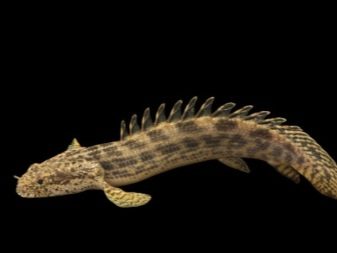
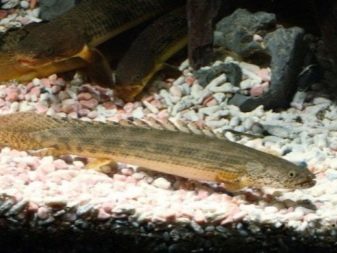
Young individuals lead a flocking lifestyle, and over the years choose loneliness and become territorial. This fish is able to recognize its owner, allows itself to stroke and eats with it. Multiopera can often be found in "show aquariums." The appearance of the dragon attracts the attention of not only children, but also adults. The behavior of this fish is very entertaining, so a lot of video clips are filmed with his participation. This predator quickly gets used to its owner and swims towards him from the shelter.
At the beginning of the twentieth century, photographs of Senegalese polyopterus were sold for a lot of money.
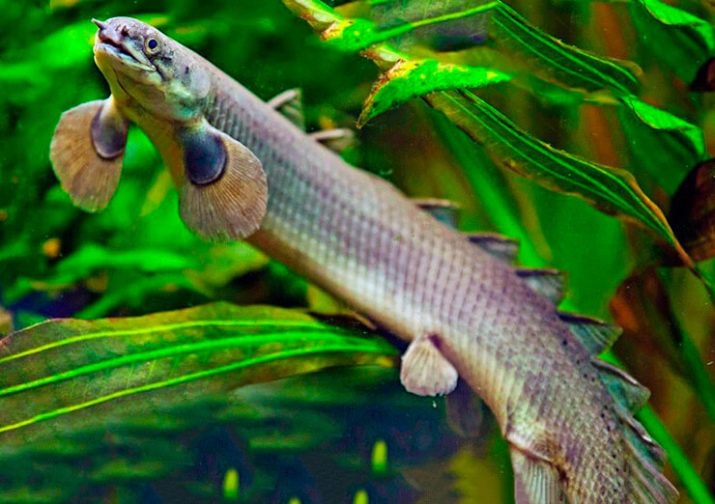
Living in nature
This "dinosaur" comes from the warm reservoirs of Africa, where it lives in the rivers Nile and Congo, lakes Chad and Turkana. It can be found in other places in the equatorial and western parts of Africa.
Local residents catch polypteruses even in road pits and various ditches, where the fish gets during river spills during the rainy season. This fish does not like strong currents and prefers to stay close to the coast, in thickets of plants and among snags, in which it is convenient to hide. They began to bring this species to Russia in the late 1990s, and to Europe a few years earlier.
Compatibility
Compatibility with other fish will not be easy, because the polytherus eats absolutely everything. He will try to eat even that which does not reach his mouth. Ideally, the size of the adjacent fish should not be less than half of the polypterus itself. If the fish is smaller, he will try to swallow it, therefore, as neighbors, large and fast individuals need to be hooked, namely:
- astronotuses;
- non-territorial cichlids;
- labyrinth fish;
- large barbs;
- knife fish;
- snakeheads;
- giant gourami;
- synodontis;
- butterfly fish;
- Akara
- afteronotuses;
- macropods;
- Calabar Kalamoikht.
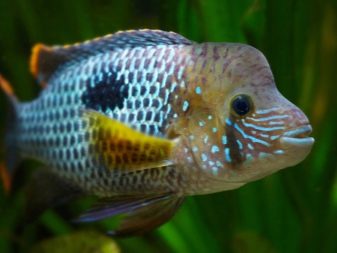
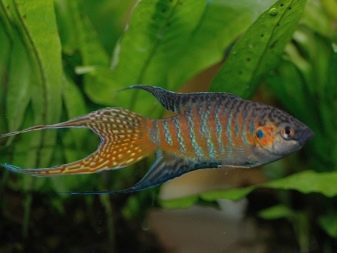
But polytherus is not the top of the food chain. There are fish with which it is incompatible, while they can kill him. The described individual is slow, therefore it is incompatible with large piranhas. Although its diamond-shaped scales and durable, the abdomen is almost defenseless in front of these predators. In addition to the abdominal part, piranhas gnaw at its fins, which can also lead to the death of polypterus. In addition to piranhas, it is not compatible with the following:
- sucking catfish;
- armored pike;
- small fish.
Growing conditions
As mentioned earlier, for a comfortable stay of this fish you will need an aquarium of at least 200 liters. It should be equipped with good filtration, not creating a strong current and aeration. Water temperature should be from +20 to +30 degrees. It’s easy to keep this fish, it’s suitable even for a beginner in the aquarium, since polypteruses are undemanding to water quality and feeding, but everything should be within reason.
Soil will suit any, only without sharp edges - Polypterus like to dig it. We must not forget about the weekly replacement of 20% of water with fresh water, cleaning in the aquarium and siphon of soil.
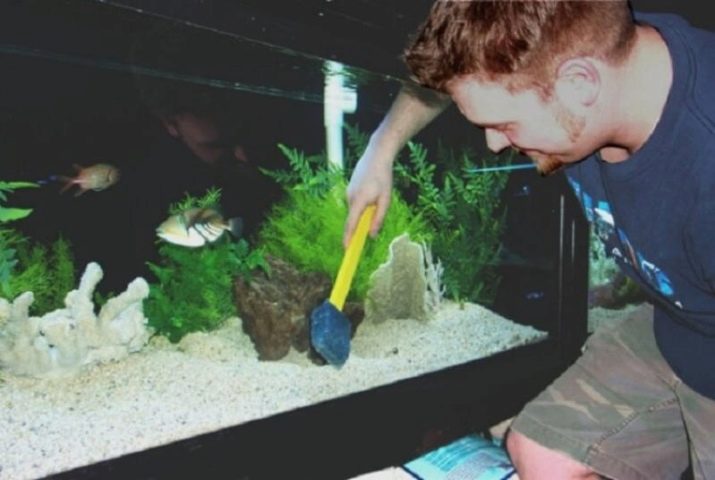
To simulate natural space will require overgrown plants, but they are best planted in pots. The presence of grottoes and various shelters will be gratefully received by the pet. The light for the described fish is not fundamental, but they prefer the twilight (if only it suits the plants). Since the fish leads a nocturnal lifestyle, it is better to feed it in the evening, shortly before turning off the light.
The aquarium must be equipped with a lid with tightly closed holes for hoses and wires, since this pet can even crawl into such a small gap and go for a “walk”. A prerequisite for the maintenance of this species is the presence of free space between the water surface and the lid. The fish sometimes pops up after a breath of fresh air. Under good conditions, this pet can live more than 10 years.
Proper feeding
Although polytherus is considered completely omnivorous, there is one very important detail in feeding - fish often die from dry food. This is due to the peculiarity of their digestive system. Very small individuals or just purchased need to be fed only with live food. An experiment with dry food is likely to result in fish death. Of live feeds, the following are well suited:
- earthworms;
- shrimp, both live and frozen;
- small fish;
- squid;
- bloodworm.
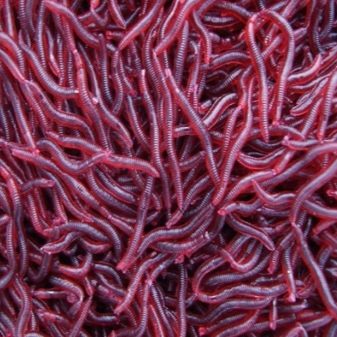
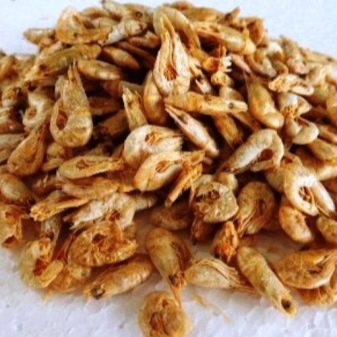
Important! Adult pets need to be fed no more than 2 times a week, otherwise obesity will begin, which will lead to lethargy and loss of interest.
Breeding
It is difficult to breed polypterus in an aquarium. Although all the individuals on sale are caught in the wild. Spawning of this specimen takes place in the homeland in the rainy season - from May to October. To stimulate spawning, you can lower the water temperature by 3-4 degrees. The main difficulty here is the volume of spawning. It should be less than 500 liters, all the bottom should be covered with Javanese moss. This is necessary to preserve offspring - parents eat caviar.
Before spawning begins, the male will begin to care for the female, pinching her fins. In the female, the abdomen is inflated at this time, and in the male the anal fin is inflated. The fish will begin to rub against each other and spin, after a while the female will begin to spawn. It will stick to plants or sink to the bottom.
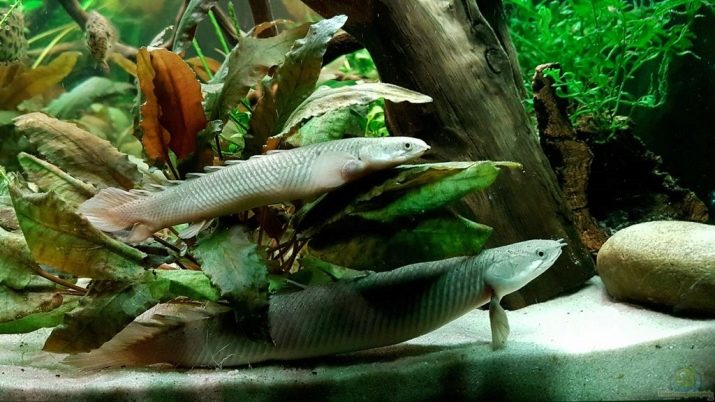
For one spawning, there can be from 400 to 4000 eggs. When the female marks all the eggs, the parents need to be removed from the aquarium or collect all the moss and eggs and transfer to another aquarium. Further, air purge and filtration come into operation. After 3 days, larvae with external gills appear, which will disappear in a month. On days 8–9, they will begin to eat on their own. Need a regular change of water to fresh from 20%.
The next difficulty is that the fry are aggressive and can eat smaller relatives, so sorting by size is needed. After a month, the kids will grow to 5 cm, then the need for sorting disappears. At the same time, they will learn to swallow air from the surface and eat any food. As they grow, they need to be transferred to a more spacious aquarium for better growth.
All about Spergalese polytherus see below.
